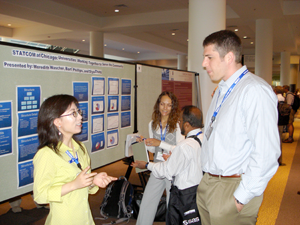Statistical Community Service: What Role Can Students Play?
Cherie A. Ochsenfeld and Gayla R. Olbricht, Statistics in the Community (StatCom), Purdue University
As our society becomes more technically integrated, the ability to collect large volumes of data becomes more feasible for even the smallest companies and organizations. Unfortunately, computing power hasn’t followed and many organizations lack the knowledge to collect data that will provide them with the most information, as well as the knowledge to analyze the data once it is collected.
Professional statisticians, through the ASA, have begun providing pro bono statistical consulting at the international and national levels through the Special Interest Group on Volunteerism. However, there is still a need for statistical consulting services at the community level. This is where student statisticians, through pro bono programs such as Statistics in the Community (StatCom), can help their communities while earning valuable consulting experience.
Local governments and nonprofit institutions provide services to community residents and want to know how to improve those services. To achieve this goal, they collect data, but do not have employees trained in data collection and analysis, or the financial resources to employ statistical consulting services. Therefore, the information gleaned from the data is minimal.
Communities benefit from having the help of a statistician. They are able to extract more information from their data and can make decisions based on statistical evidence. Community members also learn procedures that lead to sound statistical methods they can employ in the future. In turn, members of the community feel more confident about the results, as a nonbiased and trained third party has analyzed and interpreted the data. This is especially important for government and service organizations that need to make changes in policy based on the needs of the community.
Students often find it difficult to get real-world experience because examples presented during coursework are suited to teach a concept. The examples also avoid many issues associated with working on an authentic problem. Through programs such as StatCom, students learn the communication skills necessary to work with a client and explain statistical results in a meaningful way. This pro bono work allows students to make a positive change in their communities, see the effects of the statistical methods they implement, and experience how statistical analysis skills are valued. Students also feel more connected to their communities and tend to become more involved in other community activities and decisions.
Writing reports is also an essential skill for professional statisticians. Developing this skill in a group setting allows students to learn from each other. Working with the community also provides students with the opportunity to give presentations to both small and large audiences before they graduate. Additionally, involvement in pro bono statistical consulting can be included on a résumé or curriculum vitae.
StatCom at Purdue University
Graduate students in the statistics department at Purdue University started StatCom in 2001. It is a graduate student–run consulting service that serves local government and nonprofit community agencies. Services often include designing surveys, using data to make informed decisions, and identifying trends and relationships in data. Since its inception, StatCom has worked with a range of clients, including local school districts, libraries, nonprofit arts organizations, and local government entities.
The StatCom membership has included students studying graduate statistics, undergraduate statistics, psychology, and English. Students work in teams, enhancing their learning while creating friendships. Team members conduct analyses, document their results, and present their findings to clients.
The StatCom program is run and administered by students, so the program was designed to be secondary to coursework. Clients are informed of this and accept it. The general commitment level for a StatCom team member working on a project is approximately one to two hours per week.
One of Purdue University’s StatCom projects is the Sagamore Parkway Task Force. The Sagamore Parkway is an economically important roadway/area in West Lafayette, Indiana. In 2003, the mayor appointed a task force of community members and city officials to develop a plan for making improvements to the parkway area. The task force decided a major part of this effort should be conducting two surveys—one to city residents and one to business owners adjacent to the parkway—to elicit feedback on how to prioritize proposed improvements.
A StatCom team of five graduate students worked directly with the city and task force to conduct these surveys from start to finish. The team started by working with task force members to write the questionnaires. StatCom students offered guidance on question style and reviewed the questionnaires for bias. They also recommended Likert (1–5) scaling to make a quantitative data analysis possible.
After finalizing the questionnaire, the city was responsible for administering the surveys to a random sample of West Lafayette residents and all business owners near the parkway. Data from returned surveys were entered by a city official and sent to StatCom. The StatCom team conducted all data analyses and provided a written report (PDF) for both surveys.
Results were presented by the group at a public meeting, and questions from the general public were addressed. The task force created a final report that summarized their recommendations for the Sagamore Parkway area. The StatCom reports and presentations were instrumental in prioritizing these recommendations.


















